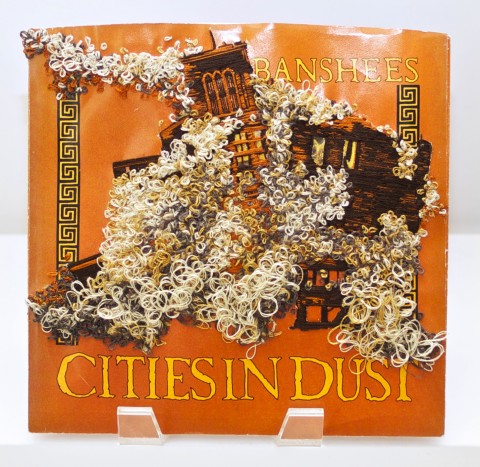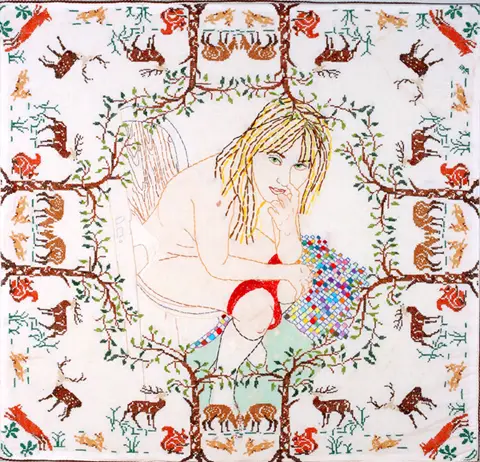
Welcome to Future Heirlooms, where we interview textile artists and explore creativity and technique.
A little late on the posting here today, apologies to all you fabulous stitchers. But I am excited to share the work and words of artist Rachel Rose with all of you today. I first came across Rachel’s work during the curatorial process of the Brooklyn show small stories and I was totally excited by her original approach to mixed media work involving the stitch. I was happy to include her work in the show and when I saw it in person I loved it even more, her choice of pixellated patterns, her very tight and neat stitching and her banal but meaningful subject matter of pets all come together to make some compelling work. I really wanted to see and know more about Rachel and her work and Future Heirlooms was the perfect excuse. So join me with Rachel Rose.
Background?
If you had to describe your work in 3 words what would they be?
More is more.

You have a series that focuses on domestic animals can you talk about how you came to this work?
Last fall, my cat Oscara fell very ill and spent a few nights at an animal hospital. Over the last six years she has been my constant companion and home didn’t feel the same without her around. It got me thinking about how our pets create the feeling of home and become intertwined in our habitat. It amazes me how we can have such a close friendship to an animal of another species. So often animals are able to fill a void that other humans are unable to.

Using images from social media allows me to incorporate other people into my work. It becomes not just about my own narrative and my own experience, but about the stories of many individuals. People upload photos of what is important to them and the memories that they want to hold on to. There is so much that you can learn about someone without ever meeting them, without ever even talking to them. Some of the images are from good friends of mine, but most of them have come from people I’ve only met a couple of times or don’t know at all.
As a whole, I think social media has allowed our culture to become much more voyeuristic. Just about everyone has looked through a profile of someone they don’t know on a social media site. Something that I think about as I am looking through profiles and compiling photographs is how people are able to control their personas. While I am able to peer into their lives, I am only seeing what they want me to see. While I can find out many intimate details about an individual’s life, I’m not really getting a full story on who they actually are.
I chose to use a pattern to fill the silhouette of the animal for two reasons. First, to remove the personality and individuality from the animal. This carries on the guise of anonymity that we tend to feel when using social media. It also represents how the animals have become so interwoven into the fabrics of “home life” that they have become practically inseparable.
You also seem to be drawn to images with banal clutter like cords, busy patterns, and general daily discards, how do you think this affects the images for you?
Banal objects like cords and beer cans are the artifacts of our daily lives. They tell the stories of how we spend our days performing completely unremarkable routines. But I admire the honesty of these objects, and the beauty of their simplicity. They are the objects that are recognizable to just about everyone regardless of age, gender, or social standing. Its makes for very democratic art during a time when people ought to be focused on commonalities rather than differences.
I’ve often wondered what attracts people to particular mediums. I think it must be in the tactile qualities. That sense that as soon as you pick up the tools they feel like they just belong in your hands. I do enjoy the tedious nature of embroidery. There is a very intimate relationship you have with the work. You have so much more time to look at the image and consider the formal and conceptual qualities of it when you embroider as opposed to drawing.
I keep a folder on my laptop of images to potentially use. Sometimes I just happen upon an image that stands out to me, other times I’m seeking out something specific. When I start working on a new piece I scroll through and decide on the particular photo I want to use, then pair it with the pattern and mediums that I think will work well with it. I tend to not plan out exactly how I’m going to execute each piece. This allows me the freedom to experiment and play without feeling constrained to stick with my original idea.

What drew me into stitching was creating an image using texture. I first started by using a very thick thread that I found in my late grandmother’s sewing box. I would create the image using only the single color of thread and then dye the finished embroidery so that the image would be revealed only through texture. I think this was influenced by my background in intaglio using only one color ink and relying on texture to create value.
As I continued experimenting with embroidery I would add color through other mediums such as dye, salt, wax, and embellishments. It was quite a while before I started working with different colored thread. I think that the more that I worked with thread, the more comfortable I became with using it in a more traditional way.

I remember being in an art supply store and overhearing a girl exclaim “I love supplies!” and I just knew exactly how she felt. Having a bigger vocabulary lets us tell better stories. Each tool has so much potential, so many possibilities for what it can create. Combining mediums makes the work so much richer, both visually and conceptually.

What is the next direction or step for your work?
I’ve begun collaging images of Detroit and embroidering them on record sleeves. All the needless worry and chatter over the end of the 13th baktun (21 Dec., 2012) lead me to consider the passage of time. Humans have changed the landscape of the world so much over the last few thousand years, but human nature hasn’t changed at all. We still suffer from the same fears and vices, still seek out love, lust, power and wealth. Detroit’s landscape has a unique way of telling these stories. I don’t think of the images of “ruin porn” as preying on the vulnerable, but about looking at our not so distant history with wonder and curiosity.
I think that the biggest challenge an artist faces is the fear of doing something to push the work farther at the risk of ruining what has already been done. Combining paint, melted wax, and other materials has the potential to erase weeks of work. Before making a bold move I always have a split second of doubt, a nagging feeling that perhaps I should slow down and reconsider before I destroy everything. Every time that I push those thoughts away it is a small victory. Working on the edge of destruction is where the best discoveries happen.

My website is http://www.rachellynnrose.com/ though I am still in the process of updating it. My most current work can be viewed at http://www.flickr.com/photos/rayroo/
I’m also going to have two new pieces in a show curated by Jamie Chalmers at MK Gallery in December. (me too!)








